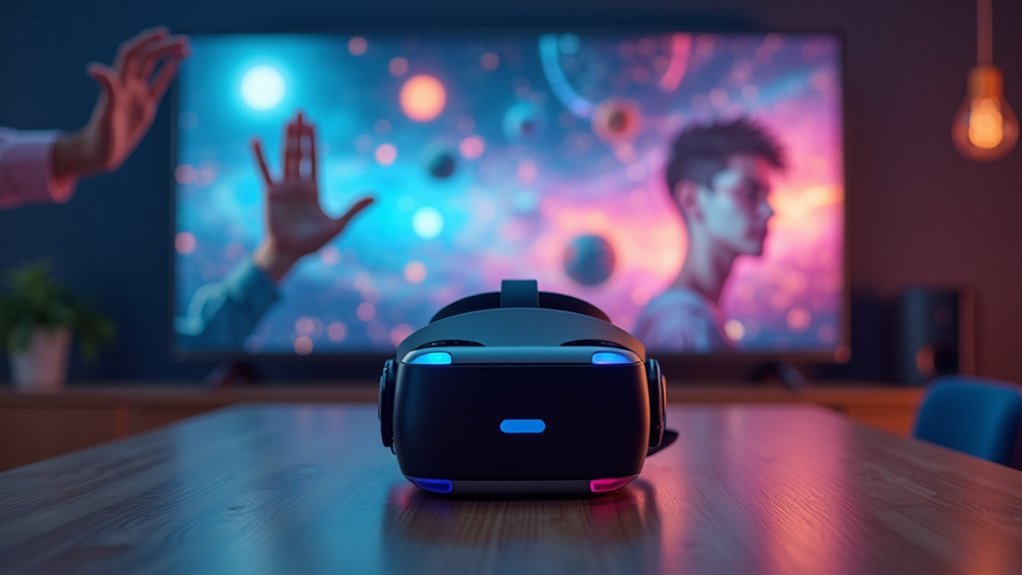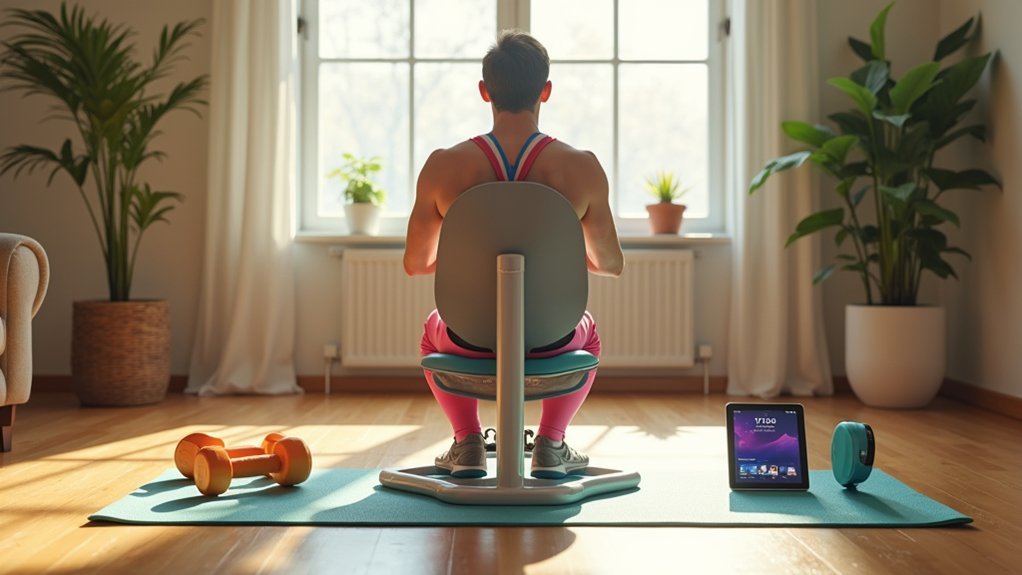You’ll want to evaluate Microsoft Azure Kinect SDK for sophisticated depth-sensing and multi-user tracking, Google MediaPipe Framework for real-time performance with exceptional accuracy, or Leap Motion SDK for ultra-precise hand tracking up to 0.1mm. Unity XR Interaction Toolkit offers cross-platform compatibility with pre-built components, while BytePlus Effects SDK provides lightweight web-based AR integration. Each option delivers low-latency gesture recognition that transforms traditional controller-based interactions into intuitive hand movements. The complete comparison reveals which SDK matches your specific development needs.
Understanding Gesture Recognition Technology in Virtual Reality

Gesture recognition technology transforms how you interact with virtual environments by translating your natural hand movements and gestures into digital commands. This advanced system provides real-time gesture tracking, analyzing your movements to create intuitive and responsive user interaction within virtual reality applications.
You’ll experience enhanced realism through touchless control, eliminating the need for traditional controllers while maintaining precise input accuracy. SDKs like BytePlus Effects offer multi-gesture functionality across various VR devices, ensuring consistent performance and seamless integration.
These immersive experiences greatly boost user satisfaction by making interactions feel natural and effortless. The technology’s accessibility benefits extend to users with physical disabilities, while its applications span gaming, entertainment, and professional training simulations, revolutionizing how you engage with digital content.
Essential Features to Look for in Gesture Recognition SDKs
When selecting a gesture recognition SDK for your virtual reality project, you’ll need to prioritize multi-gesture capabilities that support diverse hand movements and complex interactions.
Real-time hand tracking with low-latency motion tracking guarantees seamless interactions essential for immersive applications. Your chosen SDK must deliver cross-platform compatibility, allowing deployment across multiple devices without extensive modifications.
You shouldn’t overlook thorough documentation and robust support resources, which streamline integration and reduce development time.
The SDK should provide continuous updates that enhance functionality and address evolving user needs in gesture recognition technology.
These features directly impact user engagement, assuring your VR application delivers responsive, intuitive interactions that meet modern expectations for immersive experiences.
Microsoft Azure Kinect SDK for Advanced Hand Tracking
While many gesture recognition solutions offer basic hand tracking, Microsoft’s Azure Kinect SDK stands out with its sophisticated depth-sensing technology that delivers professional-grade skeletal tracking for up to six people simultaneously.
You’ll benefit from advanced algorithms that enable precise gesture recognition and intuitive interactions across gaming, VR, and interactive applications.
The Azure Kinect SDK supports multiple programming languages including C#, C++, and Python, ensuring seamless integration with your existing development workflow.
You can leverage thorough body tracking and facial recognition features to create truly immersive experiences that respond to user movements and expressions in real-time.
With cross-platform development capabilities, you’re not limited to Windows environments, making this SDK versatile for diverse project requirements and deployment scenarios.
Google MediaPipe Framework for Real-Time Gesture Detection
Since real-time performance often determines the success of gesture recognition applications, Google’s MediaPipe framework delivers exceptional speed and accuracy through its open-source multimodal machine learning pipeline architecture.
You’ll leverage advanced computer vision techniques and machine learning models to achieve precise real-time detection of hand movements in live video feeds.
MediaPipe’s lightweight design guarantees low latency performance across devices, making it ideal for immersive experiences in AR applications.
The framework’s cross-platform development capabilities enable seamless integration across Android, iOS, and web platforms.
Key advantages include:
- Customizable models that you can adapt for specific gesture recognition requirements
- High-performance tracking that maintains accuracy even on mobile devices
- Flexible integration options for various interactive media and VR applications
Leap Motion SDK for Precise Finger and Hand Movement
You’ll find the Leap Motion SDK delivers exceptional precision with hand tracking accuracy up to 0.1 mm, making it perfect for applications demanding fine motor control.
The SDK processes gestures in real-time with low latency, ensuring your interactions feel fluid and natural across VR and AR environments.
You can track both hands simultaneously with full 10-finger recognition, opening up possibilities for complex gesture-based interfaces that respond instantly to your movements.
Ultra-Precise Hand Tracking
When developing applications that demand exceptional precision in hand and finger tracking, the Leap Motion SDK stands as the industry leader for ultra-accurate gesture recognition.
You’ll leverage advanced optical sensors that deliver ultra-precise hand tracking with an impressive 150-degree field of view, enabling natural interactions without physical controllers.
The SDK transforms how you create immersive experiences by detecting multiple fingers and hands simultaneously.
You’ll benefit from:
- Low latency performance ensuring real-time responsiveness for gaming and robotics applications
- Robust cross-platform APIs supporting seamless integration across Windows, macOS, and Linux
- Comprehensive gesture support including pinch, swipe, and grab motions for intuitive interactions
This SDK enhances user engagement through its high-resolution tracking capabilities, making it perfect for training simulations and augmented reality environments.
Real-Time Gesture Processing
Real-time gesture processing with the Leap Motion SDK delivers sub-millimeter accuracy that transforms how you interact with digital environments. You’ll experience seamless gesture recognition through infrared cameras and advanced algorithms that interpret hand movements in 3D space. This precision tracking enables immersive experiences across VR, augmented reality, and robotics applications.
| Feature | Capability |
|---|---|
| Tracking Precision | Sub-millimeter accuracy |
| Processing Speed | Real-time gesture processing |
| Platform Support | Windows, macOS, Linux |
| Gesture Library | Predefined and custom gestures |
The SDK empowers you to create sophisticated user interactions without physical controllers. You can leverage predefined gesture libraries or develop custom gestures tailored to your specific application needs. This flexibility makes the Leap Motion SDK invaluable for developers seeking natural, intuitive control systems.
Unity XR Interaction Toolkit for Cross-Platform Development
You’ll find Unity’s XR Interaction Toolkit stands out as a thorough framework that streamlines cross-platform AR and VR development across devices like Oculus, HTC Vive, and ARKit/ARCore smartphones.
The toolkit’s built-in interaction patterns for grabbing, pointing, and UI manipulation let you create immersive experiences without building custom solutions from scratch.
Unity’s continuous updates guarantee you’ll maintain compatibility with the latest XR hardware while leveraging customizable input settings and seamless event system integration.
XR Framework Overview
As the XR development landscape continues to evolve, Unity’s XR Interaction Toolkit stands out as a thorough framework that bridges the gap between different platforms and devices.
This extensive XR framework enables you to create immersive experiences that work seamlessly across virtual reality and augmented reality environments. You’ll find robust gesture recognition capabilities that support intuitive controls, from pinch and grab gestures to complex hand tracking interactions with virtual objects.
The toolkit’s cross-platform applications extend your reach across multiple devices:
- Device Compatibility: Deploy on Oculus, HTC Vive, and ARKit/ARCore platforms
- Built-in Interactions: Access pre-configured object manipulation, teleportation, and UI systems
- Gesture Tracking: Implement natural hand gestures for enhanced user engagement
You’ll benefit from continuous updates ensuring access to cutting-edge tools for creating high-quality immersive experiences.
Cross-Platform Integration Benefits
While developing XR applications traditionally requires separate codebases for different platforms, Unity’s XR Interaction Toolkit eliminates this fragmentation by offering a single development environment that deploys seamlessly across VR and AR devices.
You’ll streamline cross-platform development by leveraging pre-built, customizable components for grab, teleport, and UI interactions that work consistently across Oculus, HTC Vive, and Magic Leap devices.
The toolkit’s built-in gesture recognition capabilities enable you to implement intuitive interactions without hardware-specific modifications.
You can accelerate rapid prototyping through Unity’s asset store integration, accessing compatible tools that enhance user engagement across multiple platforms. This seamless integration approach reduces development time while maintaining consistent immersive experiences.
Whether you’re building virtual or augmented reality applications, the Unity XR Interaction Toolkit guarantees your gesture-based interactions perform reliably across diverse hardware ecosystems.
Unity Development Features
Unity’s XR Interaction Toolkit delivers extensive development features that transform how you build immersive applications across VR and AR platforms.
The toolkit’s built-in support for gesture recognition eliminates complex custom coding, letting you implement hand interactions and motion interactions through an intuitive interface. Unity’s cross-platform capabilities guarantee your AR applications deploy seamlessly across Oculus Quest, HTC Vive, and mobile devices.
Key development advantages include:
- Multiple interaction methods – Direct manipulation, raycasting, and UI interactions for versatile application types
- Comprehensive developer tools – Ready-to-use components that accelerate your development timeline
- Continuous updates – Regular feature additions and compatibility improvements for emerging technologies
You’ll create immersive experiences faster while maintaining broad device accessibility through Unity XR Interaction Toolkit’s streamlined development workflow.
BytePlus Effects SDK for Web-Based AR Integration
When you’re building web-based AR applications that require sophisticated gesture recognition, BytePlus Effects SDK delivers a lightweight solution designed specifically for seamless browser integration.
You’ll access real-time hand tracking with multi-gesture support, enabling intuitive interactions across various devices and platforms without compromising performance.
The SDK’s low-latency capabilities guarantee you can develop immersive AR experiences suitable for gaming, retail, and educational applications.
You’ll benefit from extensive onboarding and thorough documentation that streamlines integration into existing web-based augmented reality projects.
BytePlus Effects offers developers a free trial to explore its functionalities before commitment.
You’ll receive continuous updates that enhance performance and features, making it an ideal choice for creating hands-free, gesture-controlled experiences that captivate users across multiple platforms.
Performance Optimization and Implementation Best Practices
Building robust gesture recognition systems requires strategic optimization techniques that maximize performance while maintaining accuracy across diverse hardware configurations.
When implementing gesture recognition for immersive experiences, you’ll need to balance computational efficiency with detection precision.
Your implementation best practices should focus on these critical areas:
- SDK Selection: Choose lightweight frameworks that minimize data consumption, CPU load, and battery usage across various devices.
- Machine Learning Integration: Deploy algorithms that adapt to different environmental conditions while reducing recognition errors.
- Feedback Systems: Implement visual feedback and audio feedback mechanisms that confirm successful gesture recognition and enhance user experience.
Regular testing across varying lighting and noise conditions guarantees consistent performance.
Leverage thorough documentation and community support to streamline integration challenges, ultimately delivering seamless performance optimization for your gesture recognition applications.
Frequently Asked Questions
What Are the Typical Licensing Costs for Commercial Gesture Recognition SDK Usage?
You’ll find commercial gesture recognition SDK licensing costs vary widely, from $500-$5,000 annually for basic tiers to $50,000+ for enterprise solutions with advanced features and unlimited deployments.
Which Gesture Recognition SDKS Work Best With Limited Hardware Processing Power?
You’ll find MediaPipe and OpenCV work exceptionally well on resource-constrained devices. They’re optimized for mobile processors and embedded systems. Ultraleap’s lightweight SDK also performs efficiently when you’re dealing with limited computational resources and need reliable tracking.
How Do Gesture Recognition SDKS Handle Users Wearing Gloves or Jewelry?
You’ll find most gesture recognition SDKs struggle with gloves and jewelry since they obscure hand features. They’ll often miss finger movements or misinterpret gestures when accessories block camera visibility or sensor detection.
Can Multiple Users Simultaneously Use Gesture Recognition in the Same Space?
You can enable multiple users to interact simultaneously in the same space, though you’ll need SDKs with multi-user tracking capabilities and sufficient processing power to handle overlapping gesture recognition accurately.
What Privacy Concerns Exist When Using Gesture Recognition SDKS With Cameras?
You’re exposing biometric data when cameras capture your movements and gestures. Your personal information could be stored, shared with third parties, or hacked, potentially compromising your identity and behavioral patterns.





Leave a Reply